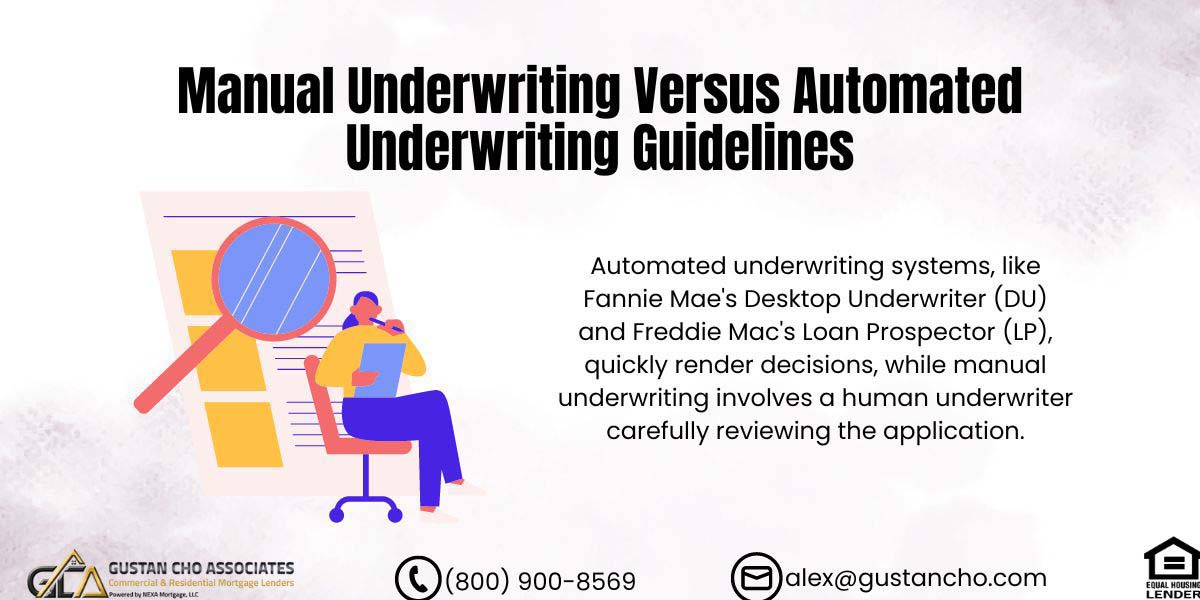In this blog, we will cover and discuss manual underwriting versus automated underwriting guidelines. The Automated Underwriting System is a sophisticated computer system and is often referred to as AUS. There are two different types of AUS. Fannie Mae’s automated underwriting system is called Desktop Underwriter and is commonly referred to as DU. Freddie Mac’s version of the automated underwriting system is referred to as Loan Prospector or often referred to as LP.
What Is The Automated Underwriting System?
The automated underwriting system is like a brain. It is a complex computerized sophisticated system that will render a decision on whether a mortgage applicant is approved for a mortgage loan. The automated underwriting system will analyze the borrowers information from the 1003, tri-merger credit report, and other data entered by the loan officer.
Within seconds, the automated underwriting system can render an automated decision. To proceed with the mortgage process, the loan officer needs to get an automated underwriting system approval or the borrower needs to be eligible on manual underwriting. FHA and VA loans are the only two mortgage programs that allow manual underwriting.
Manual Underwriting Experts—We Say Yes When Others Say No
Got a refer/eligible finding? Don’t worry—our manual underwriting team specializes in FHA and VA loans that banks often deny.What is the Difference Between Manual Underwriting and Automated Underwriting?
The automated underwriting system can render findings in a matter of seconds. DU and LP are two separate AUS. In most cases, both Fannie Mae’s DU and Freddie Mac’s LP will render the same decisions. However, there are other times where one AUS may give an approval and the other may render a denial. For example, Freddie Mac LP may be more forgiving on late payments after bankruptcy and/or foreclosure on a particular borrower than Fannie Mae’s DU and vice versa on a different borrower.
Automated Underwriting System Findings
There are three different automated findings the AUS will render:
Approve/eligible per AUS:
- The borrower has been approved per AUS.
Refer/eligible per AUS:
- The borrower may be eligible but the AUS cannot determine an AUS approval but can be manually underwritten.
Refer with Caution per AUS:
- This finding means the borrower is denied and does not meet the guidelines of the mortgage program.
Trying To Get a Refer/Eligible to an AUS Approval
When a loan officer cannot get an approve/eligible per AUS, the loan officer can try to play around with the AUS system such as adding more down payment, adding more reserves, or other positive factors in order to get an approve/eligible per AUS.
Manual Underwriting Versus Automated Underwriting Guidelines: Information Analyzed To Render The Automated Findings
The Automated Underwriting System will take into account the mortgage applicants following information:
- Income
- Debt
- Liabilities
- Assets
- Credit scores
- Credit history
- Public Records
Conditions From the Automated Underwriting System Findings
Based on the information, the Automated Underwriting System will report its findings and can require conditions like the following:
- Rental verification
- Reserves
- Assets
- Whether or not gift funds can be used
- Other mortgage conditions
Fannie Mae’s version of Automated Underwriting System is known as DU and Freddie Mac’s version is known as LP. Findings from the Automated Underwriting System are rendered as approve/eligible, refer/eligible, or refer with caution.
What is the DTI for Manual Underwriting?
In manual underwriting, the Debt-to-Income (DTI) ratio is crucial in assessing a borrower’s creditworthiness. DTI ratio is a borrower’s monthly debt payments divided by their gross monthly income. Lenders have guidelines for acceptable ratios, and lower ratios indicate better financial health. However, acceptable DTI ratios can vary depending on factors such as the type of loan, the lender’s policies, and the borrower’s overall financial situation.
Lenders may scrutinize the DTI ratio more closely than in automated underwriting systems, as manual underwriting involves a more thorough assessment of the borrower’s financial profile. Lenders can consider compensating factors while assessing a borrower with a higher DTI ratio. These compensating factors may include a robust credit history, considerable cash reserves, or steady employment.
While there is no universal DTI threshold for manual underwriting, a DTI ratio of 43% or lower is often considered favorable by many lenders. Still, exceptions can be made based on other factors. Borrowers need to discuss DTI requirements with their lenders to understand the specific criteria for manual underwriting.
Difference Between Manual Underwriting Versus Automated Underwriting
The Approve/Eligible is rendered on automated underwriting and refer/eligible is rendered on manual underwriting. Refer/eligible files are mortgage applications that are eligible for mortgage approval but is not approved due to certain factors that the automated underwriting system cannot render an automated approval. A mortgage underwriter needs to carefully review the borrowers file manually.
Key Factors Reviewed by Mortgage Underwriters
Information such as the following needs to be reviewed carefully and analyzed by the underwriter:
- Credit Scores
- Overall Credit Payment History
- Assets
- Debt to income ratios
- Compensating Factors
- Other factors that the automated underwriting system cannot render an approve/eligible per AUS
Mortgage underwriters have a lot of underwriter discretion on manual underwrites. Mortgage underwriters can approve a manual underwrite with late payments in the past 24 months if she believes it was due to extenuating circumstances and the borrowers have strong compensating factors.
Potential Reason For Refer/Eligible AUS Findings
There are multiple reasons why borrowers do not get an approve/eligible and the AUS renders a refer/eligible. Refer with caution pretty much means a denial due to certain factors that do not meet Fannie Mae, Freddie Mac, or FHA mortgage lending guidelines such as the following:
- Borrower not having met the mandatory waiting period after a housing event )foreclosure, deed in lieu of foreclosure, short sale)
- Did not meet the mandatory waiting period after Chapter 7 bankruptcy
- Other factors that the Automated Underwriting System picked up
For files that do not meet automated underwriting system guidelines, the files can be manually underwritten.
Confused by Automated vs. Manual Underwriting?
Let our expert loan officers guide you through the difference—and help you get the approval you deserve, even with a challenging file.Manual Underwriting Needs To Go Through Lender Who Does Manual Underwrites
Not all mortgage lenders can do manual underwriting mortgage applications. You can only do manual underwriting on FHA and VA loans. The mortgage guidelines on manual underwriting is the same on both FHA and VA loans when it comes to debt to income ratios and compensating factors. Gustan Cho Associates is a mortgage company licensed in multiple states with no lender overlays on government and conventional loans. The team at Gustan Cho Associates are experts in manual underwriting.
What is the Purpose of the Underwriting Manual?
The underwriting manual is a comprehensive document that provides clear guidelines and procedures for underwriters evaluating loan applications. Its primary aim is to establish consistency, accuracy, and adherence to regulations throughout the underwriting process.
By setting standardized criteria, the manual ensures that all underwriters within an organization follow the same procedures when assessing loan applications. It is a critical tool for maintaining compliance with regulatory standards set by bodies such as the Consumer Financial Protection Bureau (CFPB) or Fannie Mae/Freddie Mac.
Moreover, the manual aids in risk management by outlining factors to consider, such as credit history, income verification, and collateral evaluation, enabling underwriters to assess the level of risk associated with each application.
It also acts as a useful tool to educate newly hired underwriters and as a guide for experienced ones, furnishing them with the essential data and standards to arrive at educated conclusions about the endorsement or rejection of loans. Regular updates to the manual ensure that it remains relevant and adaptable to changes in regulations, market conditions, and organizational policies. The underwriting manual facilitates efficient, consistent, and compliant loan underwriting processes within financial institutions.
Manual Underwriting Mortgage Guidelines
For those that do, there are more restrictions that apply than automated approved mortgage files. Manual underwriting is done for files that cannot get automated underwriting system automated approvals. Manual underwriters look for strong compensating factors such as rental verification, reserves, larger down payment, and lower debt to income ratios.
Debt to Income Ratio on Manual Underwriting
Manual underwriting maximum debt to income caps can be as high as 40% front end and 50% back end DTI with two compensating factors. Maximum debt to income ratios is capped at 37% front end and 47% back end with one compensating factors. Maximum debt to income ratios is capped at 31% front end and 43% back end with two compensating factors.
Mortgage underwriters can surpass the above debt to income ratios on manual underwrites if the underwriter discretion permits it. Underwriters have a lot of power on manual underwrites.
Borrowers With No Credit Scores Need To Be Downgraded To A Manual Underwrite
For mortgage loan borrowers with no credit scores, a manual underwriting mortgage approval process can get them a mortgage approval by using non-traditional credit such as the following:
- Rental verification
- Electric bills
- Water bills
- Cable bills
- Internet bills
- Cellular bills
- Insurance bills
- Tuition
- Other alternative sources
The way to prove that is by providing the mortgage underwriter 12 months worth of cancelled checks.
What are the Disadvantages of Manual Underwriting?
Manual underwriting, while offering flexibility and personalized assessment, presents several drawbacks. Firstly, it is time-consuming compared to automated processes, potentially leading to delays in loan approvals. Moreover, it demands significant human resources, including trained underwriters, which can increase operational costs for lenders.
The subjective nature of manual underwriting introduces the risk of inconsistent outcomes, as different underwriters may interpret criteria differently. Additionally, human judgment may inadvertently introduce bias into decisions, impacting certain groups unfairly.
Manual underwriting may not be easily scalable to handle high volumes of applications efficiently, and human error can lead to inaccuracies in assessing creditworthiness, potentially resulting in inappropriate approvals or denials. Ultimately, these factors can contribute to higher costs for borrowers and limited access to credit, particularly if lenders do not offer manual underwriting.
Despite its drawbacks, manual underwriting remains valuable for situations where automated systems may not adequately assess a borrower’s financial situation.
VA And FHA Loans During And After Chapter 13 Bankruptcy
Gustan Cho Associates empowered by NEXA Mortgage, LLC NMLS 1660690 is a mortgage company licensed in multiple states with no lender overlays on government and conventional loans. A large percentage of our borrowers are folks who are in a Chapter 13 Bankruptcy repayment plan and/or just got their Chapter 13 Bankruptcy discharged. Most mortgage lenders have overlays on VA loans during and after Chapter 13 Bankruptcy and FHA loans during and after Chapter 13 Bankruptcy.
Manual Underwriting Versus Automated Underwriting Mortgage Lenders
Gustan Cho Associates has no lender overlays on Chapter 13 Bankruptcy during and after Chapter 13 Bankruptcy discharge on both FHA and VA loan programs. Both FHA and VA Loans without two years of seasoning after Chapter 13 Bankruptcy discharged date need to be manually underwritten. This is because the Automated Underwriting System will not render an approve/eligible per AUS.
Qualifying For Mortgage With a Lender With No Overlays
Borrowers who need to qualify for a mortgage with a national mortgage company with no lender overlays on government and conventional loans can contact us at Gustan Cho Associates at 800-900-8569 or text us for faster response. Or email us at gcho@gustancho.com. We are available 7 days a week, evenings, weekends, and holidays.
A large percentage of our borrowers are files that need to be manually underwritten. All of our pre-approvals are TBD Subject Property Mortgage Underwriting so they are full credit approvals that are fully underwritten and signed off by our mortgage underwriters.
FAQ: Manual Underwriting Versus Automated Underwriting Guidelines
-
1. What is the Automated Underwriting System (AUS)? The Automated Underwriting System is a sophisticated computerized system, often referred to as AUS, that renders decisions on mortgage loan applications. It analyzes borrower information from various sources, such as the 1003 form and credit reports, to determine eligibility for a mortgage loan.
-
2. What are the differences between Manual Underwriting and Automated Underwriting? Automated underwriting systems, like Fannie Mae’s Desktop Underwriter (DU) and Freddie Mac’s Loan Prospector (LP), quickly render decisions, while manual underwriting involves a human underwriter carefully reviewing the application. Manual underwriting is typically required for FHA and VA loans.
-
3. What are the findings from the Automated Underwriting System? AUS findings can be “Approve/eligible per AUS,” “Refer/eligible per AUS,” or “Refer with Caution per AUS,” indicating various levels of approval or denial.
-
4. What information does the Automated Underwriting System analyze? The AUS considers income, debt, assets, credit scores, credit history, public records, and other relevant financial data.
-
5. What are the disadvantages of manual underwriting? Manual underwriting can be time-consuming, resource-intensive, and prone to subjective decision-making and human error. It may also lead to higher costs for borrowers and limited access to credit.
-
6. What is the Debt-to-Income (DTI) ratio for Manual Underwriting? In manual underwriting, the DTI ratio, which measures a borrower’s debt relative to their income, is crucial. While there’s no universal threshold, lower ratios are generally preferred, with 43% or lower often considered favorable.
-
7. Why might a borrower receive a Refer/Eligible finding from the Automated Underwriting System? A Refer/Eligible finding means the borrower may be eligible for a mortgage but requires manual underwriting due to certain factors that the AUS cannot automatically approve.
-
8. Can borrowers with no credit scores qualify for a mortgage? Yes, through manual underwriting, borrowers with no credit scores can still qualify for a mortgage by providing the underwriter with alternative credit sources, such as rental payments or utility bills.
-
9. How can borrowers qualify for a mortgage with a lender with no overlays? Borrowers seeking mortgages without lender overlays can contact companies like Gustan Cho Associates, which have no additional requirements beyond government and conventional loan guidelines.
-
10. What is the purpose of the underwriting manual? The underwriting manual provides clear guidelines and procedures for underwriters to ensure consistency, accuracy, and regulation compliance throughout the underwriting process.
This blog about Manual Underwriting Versus Automated Underwriting Guidelines was updated on April 3rd, 2024.










